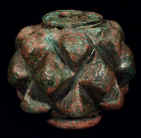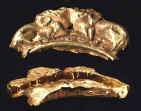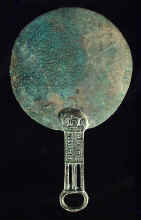255
BRONZE MACE OR SCEPTER
LURISTAN
VIII-VII c. B.C.
The cast in one piece cylinder with pyramidal spikes, rhomboidal in cross section, through hole of a conical shape. Finial of this type must be mounted on poles, which have not survived. At the top, in the shallow groove under the collar, there is a perpendicular hole to the axis with remains of a pin for attachment to the pole. D. 1.6"(4 cm), H. 1.6"(4 cm).
See: Calmeyer P. Datierbare Bronzen aus Luristan und Kirmanshah, in Untersuchungen zur Assyriologie und vorderasiatischen Archäologie 5, 1969, pg119; L. Vanden Berghe, Les tombes de l'age du fer au Luristan. La necropole deDjub-i Gauhar, in: Archeologia 138, 1980. pg. 32ff; Mit Hieb und Stich. Bronzewaffen aus dem alten Iran. Die Sammlung von Grawert. Frakfurt am Main, 2001. pg. 65.
$ 1250
1001
SCYTHIAN FINIAL
VII-VI c. B.C.
Hollow cast bronze. The finial's tapering conical shaft cast is in the form of a bird of prey's neck with a massive hooked beak and abstractly modeled prominent eyeballs. There are several holes at the shaft for attachment to the wood. H. 1.2" (3.0 cm).
Finials of this type, but larger, must be mounted on poles and were used for cultic purposes. Most likely the depicted bird is a scavenger, whose image is strongly connected to the underworld. See: E.C.Bunker, J.F. So. Traders and Raiders on China's Northern Frontier. Smithsonian Institution, 1995, pg. 121, cat.38.
$ 1250
534
SCYTHIAN GOLD HANDLE
IV c. B.C.
The sheet-gold horizontal handle was once attached to the rim of wooden vessel, which has not survived. The plaque hammered over a matrix, depicting two mirror images of feline predators with their heads turned back with mouth open and fangs bared. It was hammered over a wooden mold and then wrapped around and nailed from the bottom and finally to the rim. Two rows of gold nails survived: eight from the bottom and nine along the rim. 80 x 38 x 12 mm.
Wooden vessels found in European Scythian graves dating from the fifth and fourth centuries B.C. in male burials and never in women's. Most scholars have suggested ritual purposes of decorated wooden vessels, particularly that predators may be linked symbolically to the world of the dead and sacrificial offerings; or used in an orgiastic rite connected with the hallucinogenic plant Peganum harmala or mushroom Amanita muscaria in Soma/ Hauma Cult.
For a similar handle see: The Golden Deer of Eurasia. The Metropolitan Museum of Art, Yale University Press, 2000, cat. 81, 158. For a similar iconography see: Piotrovsky B. Scythian Art. Phaidon, Oxford, 1987, cat. 174.
$ 3750
353
LURISTAN BRONZE BELL
VII c. B.C.
Wax-casting bronze. Conical with round bottom open-work cage with two balls inside. Bottom has triangular openings along the perimeter. Conical wall with triangular openings at lower part and biconical band with engraved hatched lines. Topped with a knob with rectangular opening for suspension.
H. 2.6" (6.5 cm).
Scholars believe that the function of these bells were rather cultic, then utilitarian: the sound of ringing could speak to the Gods.
See: Bouzek. J. Graeco-Macedonian bronzes. Praha, 1973, p.62, fig. 19, 68 ; Bouzek. J. Caucasus, Luristan and Greek Geometric Bronzes. "Annales Archeologiques Arabes Syriennes". Damas., Vol.21, 1971,# 7, tbl. 2.
$ 850
995
BRONZE SNAKE
VII-VI c. B.C.
Cast and forged bronze. Ornament in the form of a coiled snake. The body interspaced with rhomb-shape notches. Being flat on reverse, there is no sign of attachment, indicating cultic function rather than decorative. L. 1.3" (3.4 cm).
$ 250
443
BRONZE MIRROR
WESTERN ASIA
VI c. B.C.
Disk and handle were cast separately. Large flat disc, polished on both sides. Handle cast in two-part mold with casting seam along the perimeter. Open-work handle with oval-shaped loop as lower termination, covered entirely by geometrical design in relief, including upper termination. From reverse, only middle part is decorated with engraved diagonals at rectangular portion of the handle. D. 7.5" (19.1 cm), H. 12.8" (32.5 cm).
$ 3000
941
BRONZE CAULDRON HANDLES
VIII-VII c. B.C.
Riveted bronze cauldron with opposed vertical handles. Each with round cross-section and terminated with stylized predator heads with rhomboidal ears. Attached to to cauldron by wide open biting mouth. Fragment of cauldron's wall is preserved, the vertical seam is riveted. H. 5.1"(13 cm) for fragment with the wall.
$ 500







